The Orchestra’s History
Its concert debut in 1923 makes the Cologne Chamber Orchestra the oldest German chamber orchestra. The concept of interpretations appropriate to the work in question led to the founding of the Cologne Chamber Orchestra in 1923; during its earliest years it performed under the baton of Hermann Abendroth, later under Erich Kraack. Since then, music historians were able to document the founding concert on November 30, 1923 at the concert hall of the new building of the Kunstverein on Cologne’s Friesenplatz, as part of the concert series of the Society for New Music. This first concert was conducted by Gustav Classens, who had studied piano performance and conducting with Hermann Abendroth at the Cologne Conservatory since 1914 and would go on to become Bonn’s Music Director from 1933 to 1949, exerting considerable influence on local cultural life. Under the direction of Otto Klemperer and Hermann Abendroth, during the 1920s the newly-founded orchestra also performed at the “Rhenish Chamber Music Festivals” in Cologne every May and at the concert hall of Brühl Palace.
When Abendroth left Cologne in the early 1930s, his student Erich Kraack took over as conductor of the young ensemble, moving its operations to Leverkusen. There, he was able to cement its good reputation at the Bayer Casino Concerts, gaining international attention by working with major soloists. Erich Kraack exerted considerable influence on the concert and cultural life of the city of Leverkusen for 36 years, during which he was also the artistic director of the Bayer Philharmoniker.
In 1963 Erich Kraack turned the leadership of the Cologne Chamber Orchestra over to Helmut Müller-Brühl. The latter had studied philosophy, Catholic theology, art history and musicology, acquiring a comprehensive theoretical foundation for the interpretation of baroque and classical music, complemented by violin courses with his mentor Wolfgang Schneiderhan and by beginning to conduct early in life. In the autumn of 1964, he took the Orchestra and pianist Wilhelm Kempff on a much-acclaimed tour of Switzerland, marking the beginning of the Orchestra’s collaboration with many renowned soloists. Ever since, the Orchestra has celebrated many a success on tour in Europe, Asia, North and South America and at festivals in Germany and abroad.
Helmut Müller-Brühl opened up a new venue for the musicians – as a resident orchestra, they performed opera and concerts at the Brühl Palace Concerts, an institution he directed artistically for more than three decades.
From 1976 to 1986, the Cologne Chamber Orchestra performed exclusively on historical instruments and under the name Capella Clementina. During this time, Helmut Müller-Brühl created benchmarks for historically informed performance practice and the revival of baroque musical theatre. Since 1987 the Cologne Chamber Orchestra has transferred the insights gained during this period to its performances on modern instruments. Thus, today the Cologne Chamber Orchestra is a formation which is historically informed and inspired, yet commands a modern sound, enabling it to perform a repertoire ranging from the baroque to classical works, classical modernism and contemporary pieces.
The Cologne Chamber Orchestra has presented its own concert series “Das Meisterwerk” (“The Masterwork”) at Cologne’s Philharmonie since 1988 – beginning just one year after the hall was opened to the public.
From 1997 to 2007 the Cologne musicians appeared regularly at the Théâtre des Champs-Elysées in Paris and at Munich’s Prinzregententheater. One essential characteristic of the “Masterwork” concerts was the presentation of gifted young musicians under Helmut Müller-Brühl’s baton, both within the ensemble and as soloists.
The Cologne Chamber Orchestra has participated in more than 200 recordings for CD, radio and television productions, featuring over 500 compositions. Since 1995 it has been affiliated with the Naxos label, thereby gaining a worldwide presence. On the occasion of the Bach Year 2000, it recorded Johann Sebastian Bach’s complete orchestral works under Helmut Müller-Brühl’s baton, assembling on CD for the first time all 35 suites and concerti in the original versions that have come down to us, in transcriptions made by the composer himself and in more recent reconstructions of originals believed lost. In the meantime, the ensemble has added all of Bach’s 16 solo cantatas on four CDs – a welcome complement for its recordings of the Mass in B-Minor and the St Matthew Passion. In 2001 its recording of the three Darmstadt Overtures by Georg Philipp Telemann won the Cannes Classical Award in the category “18th Century Orchestral Music”. In 2003 Helmut Müller-Brühl and the Cologne Chamber Orchestra embarked upon a complete recording of Ludwig van Beethoven’s symphonies; only the Ninth Symphony is still outstanding today.
Over the course of 2007 they recorded 24 instrumental concerti by Joseph Haydn, ten of which had never been recorded before in the original instrumentation. On the occasion of the 200th anniversary of Haydn’s death, the Cologne Chamber Orchestra and Helmut Müller-Brühl were invited by Pope Benedict XVI to provide the music for the 2009 Whitsun service at St Peter’s Cathedral in Rome.
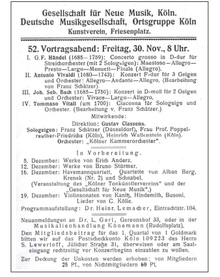
Programme of the founding concert

Performance of the Brandenburg Concerto No. 6 at the 1925 Rhenish Chamber Music Festival at the concert hall of Schloss Brühl.
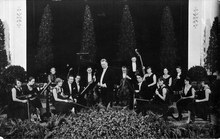
The Cologne Chamber Orchestra with Hermann Abendroth in 1933.
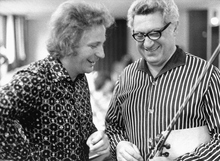
Helmut Müller-Brühl and Wolfgang Schneiderhan in 1973
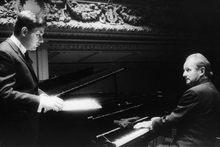
Helmut Müller-Brühl and Wilhelm Kempff at the Tonhalle Zürich, 1964.
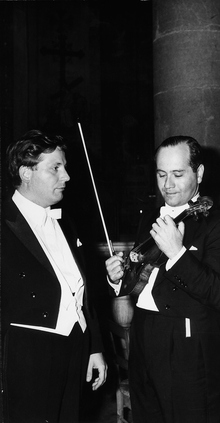
Helmut Müller-Brühl and Igor Oistrach at the Festival de Musique Menton, 1968.
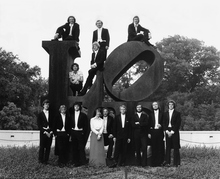
The Cologne Chamber Orchestra in 1974 on a sculpture by Robert Indiana in front of the Indianapolis Museum of Art.
At the beginning of the 2009/09 season, Helmut Müller-Brühl passed the artistic directorship of the Cologne Chamber Orchestra on to Christian Ludwig, who was its successful chief conductor for three seasons.
Christian Ludwig was born in 1978 in Cologne. A fellow of the German National Academic Foundation, he studied violin in Cologne and London and chamber music with the Alban Berg Quartet. As a soloist, he appeared with renowned orchestras such as the Radio Symphony Orchestra Saarbrücken, the Berliner Sinfonie-Orchester, the Radio Symphony Orchestra Beijing and the Franz Liszt Chamber Orchestra in Budapest. He has performed at numerous festivals, including the International Music Festival Davos, the Dresden Music Festival and the Rheingau Music Festival. Apart from recording for various radio stations, he also recorded J. Haydn’s and F. Mendelssohn’s violin concerti and a CD with works for violin and cello. After sustaining a hand injury, Christian Ludwig studied orchestral and choral conducting with Klaus Arp at the Music Academy in Mannheim and with Sir Colin Davis and Colin Metters at the Royal Academy of Music in London. He received further musical inspiration from master courses with conductors such as Mario Venzago, Dmitri Kitajenko, Yan Pascal Tortelier and George Hurst. In 2011 Christian Ludwig was appointed chief conductor of the Gwangju Symphony Orchestra in South Korea.
Christian Ludwig continued the cooperation with Naxos, recording the complete string serenades by Robert Fuchs (1847-1927) with the orchestra. Thus, he set the direction for the Cologne Chamber Orchestra’s repertoire expansion towards the 20th century.
During the 2011/12 and 2012/13 seasons, the Cologne Chamber Orchestra worked mainly with international guest conductors such as Nicholas McGegan and Jos van Veldhoven, sharpening its profile by collaborating with high-profile experts in baroque music. Great choral works with familiar partners such as the Collegium vocale Siegen under Ulrich Stötzel or the Chorus of the Cologne Music Academy under Reiner Schuhenn formed part of the programme, as did concerts with young soloists led by the concertmaster. Helmut Müller-Brühl returned one more time to the conductor’s podium in the autumn of 2011, recording W. A. Mozart’s Divertimenti K. 251 and K. 334 together with “his” orchestra. This is currently the Orchestra’s most recent recording.
By appointing Christoph Poppen as principal guest conductor starting in September 2013 and as principal conductor since 2014 the Cologne Chamber Orchestra has accomplished an important artistic reorientation.
Helmut Müller-Brühl was born in Brühl in 1933. There, he attended elementary school and a humanistic grammar school, serving as an altar boy and leader of various youth groups. There he also took his first violin lessons and was an enthusiastic member of the school orchestra. After graduating, he first joined the Archiepiscopal House of Studies in Bonn as a seminarian, studying philosophy and theology. However, after only a few semesters a severe health crisis forced him to leave the Collegium Albertinum. Having contracted tuberculosis, Müller-Brühl travelled to the Disentis Monastery in Grisons (Switzerland), the oldest Benedictine abbey north of the Alps. The well-meaning abbot enabled him to attend the Lucerne Conservatory, where the novice met Wolfgang Schneiderhan, one of the most important violinists of the time. This encounter changed everything: in Schneiderhan, Müller-Brühl had found a mentor, teacher and friend.
Having returned to the lowlands, the young violinist continued to study philosophy and theology, but also art history and musicology with teachers including Joseph Ratzinger, Heinrich Lützeler and Josef Schmidt-Görg. He also strove to realise his own musical dreams. It was not only 18th century music which fascinated Müller-Brühl, but the unique confluence of all spiritual and artistic powers at the time in the total work of art which was the baroque period, that paradox attempt to unify the conflicts between lust for life and death-wish, sumptuousness and transience of the world, through music. What was more obvious than performing the music of the 18th century at original, genuine locations, such as the ones offered by the Brühl Palace?
Reviving the tradition of the Rhenish Chamber Music Festivals of the early 1920s, Müller-Brühl initiated the Brühl Palace Concerts in 1958, as well as his first orchestra, the Young String Ensemble Cologne. Starting in 1960, the Cologne Soloist Ensemble united members of the large Cologne-based orchestras and the Cologne Music Academy around the young conductor, pursuing the same goals. Three years later, the Cologne Chamber Orchestra performed for the first time in the splendid stairwell of the Elector’s Residence, where it became the house ensemble for almost 30 years.
Soon thereafter, Augustusburg Palace became the podium for important soloists: these included singers Irmgard Seefried and Maria Stader, violinist Wolfgang Schneiderhan, cellists Gaspar Cassadó and Pierre Fournier and pianists Jörg Demus and Wilhelm Kempff.
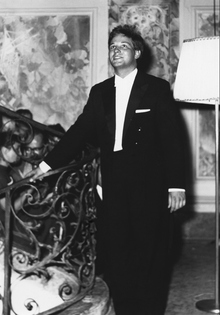
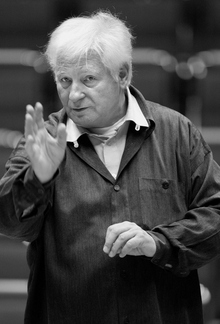
Müller-Brühl was an early proponent of original sound, of historicised musical events. And indeed, his ensemble, which had played historical instruments since 1976 under the name Capella Clementina and performed with musicians such as Reinhard Goebel, Thomas Hengelbrock, Konrad Hünteler, Rainer Kussmaul, Michael Schneider and Peter Westermann, soon advanced to become one of the first authorities on the authentic interpretation of early music. However, musical historicism created new dogmas.
Few recognised this as early as Helmut Müller-Brühl. And hardly any were willing to draw consequences from this insight, as he was. The inauguration of the Cologne Philharmonie in 1986 provided the final trigger. On the basis of detailed knowledge of historical performance and playing practice, Müller-Brühl rehearsed each and every work carefully with his musicians, examining and rejecting details and marking every part himself, down to the last up-bow. Thus, he always conducted from the score, but since the founding of the Capella Clementina never with a baton, always with his hands only, and mainly with his eyes. The fact that Helmut Müller-Brühl considered everything through the lens of didactics was not lost on, but rather valued by his faithful audience. And of course he never neglected another dialogue: that with young master soloists. Whether Barbara Schlick or Christine Schäfer, Michael Chance or Thomas Quasthoff, Frank Peter Zimmermann or Maxim Vengerov, Justus Frantz or Olli Mustonen – they were all Helmut Müller-Brühl’s guests, and many of them made their Cologne debuts under his care.
The recordings made by Müller-Brühl since 1960 also have a certain didactic quality. His record series “Masterworks for Orchestra”, “The Instruments of the Orchestra” and “Concerti per varii stromenti” sought and found a broad audience. He had produced more than 200 recordings when he signed an exclusive contract with Naxos in 1995, allowing him to record core repertoire – Bach, Haydn, Mozart and Beethoven. This fruitful collaboration with a label with worldwide operations was an important touchstone for Müller-Brühl’s concept of producing valid interpretations of early music on modern instruments – a concept he pursued not least with his breathtaking new recording of Johann Sebastian Bach’s complete orchestral works, which sold unusually well. However, it was not just commercial success that proved Müller-Brühl right. After all, his recording of Telemann’s three Darmstadt Overtures won the Cannes Classical Award in 2001, one of the most important critics’ awards. Müller-Brühl was the director, conductor and manager of the Cologne Chamber Orchestra in one. And here as everywhere, he did what he always did: he sought dialogue. He assembled personalities from commerce, banks and industry in an association of supporters in 1989, giving the Cologne Chamber Orchestra, one of the unsubsidised ensembles in Germany, a degree of planning security hardly known anywhere else anymore. It was part of the responsibility Müller-Brühl felt for his orchestra to hand over the directorship of the Brühl Palace Concerts to Andreas Spering already at the end of 1995; similarly, in 2008 he also gave the directorship of the Cologne Chamber Orchestra into the younger hands of Christian Ludwig.
In the autumn of 2011 Helmut Müller-Brühl returned to the conductor’s podium once more to record Mozart’s Divertimenti K. 251 and K. 334.
Possibly, his most intensive musical experience was the invitation from Pope Benedict XVI in 2009 to provide the music for the Whitsun Service at St Peter’s Cathedral in Rome on the occasion of the 200th anniversary of Haydn’s death.
In January 2012 friends and colleagues said farewell to Helmut Müller-Brühl, who died on January 2, 2012 in his hometown of Brühl.